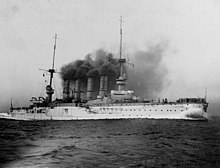German commerce raiders in World War I

The German commerce raiders of World War I were surface vessels used by the Imperial German Navy for its Handelskrieg ("Trade war"), a campaign against Allied seaborne trade. The ships comprised warships, principally cruisers, stationed in the German colonial empire before the war began, express liners commissioned as auxiliary cruisers and later, freighters outfitted as merchant raiders. These vessels had a number of successes and had a significant effect on Allied naval strategy, particularly in the early months of the war.
Cruisers
At the outbreak of the

At the outbreak of war, the East Asia Squadron was at sea and sailed eastwards across the Pacific to attack British and Allied shipping. He had with him
Nurnberg which had been on detached service, sent to relieve Leipzig had rejoined the East Asia Squadron on the outbreak of war. She had encountered no Allied shipping and made no captures; she was sunk at the Falklands. Leipzig had been at
Emden (
The cruiser Konigsberg and the gunboat Geier were in German East Africa. Konigsberg set out one raiding voyage to the Gulf of Aden and sank a ship; in September she surprised and sank the British cruiser HMS Pegasus in Zanzibar harbour. Lack of coal limited her operations and fear of being cornered in a harbour led to her captain taking refuge in the Rufiji River delta. Konigsberg was discovered in October and the channel to the sea blocked in November; Konigsberg was destroyed six months later. Geier sailed in August and crossed the Indian and the Pacific oceans in search of Allied ships but in three months captured only one ship before interning herself at Honolulu.
In the west, the most successful cruiser was Karlsruhe (Fregattenkapitän Erich Kohler). After meeting and equipping the liner Kronprinz Wilhelm, Karlsruhe set out on a raiding voyage along the South American trade routes. Using her attendant supply ships and prizes to scout for her, Karlsruhe moved through the ocean, able to steam quickly to any target or to evade interception. After two months she had captured and disposed of 16 ships, including one neutral Dutch freighter and taken 500 prisoners. At the end of October the prisoners were dispatched to neutral Tenerife in one of the prizes and Karlsruhe steamed north to raid in the Caribbean. On 4 November 1914, 300 nmi (350 mi; 560 km) east of Barbados, Karlsruhe suffered a calamitous internal explosion, killing Kohler and 260 members of the crew. The survivors were rescued by the supply ship Rio Negro, which had been in attendance and returned to Germany. Before the secret of her loss was exposed in March 1915, Karlsruhe exerted an influence as a ghost ship on British naval strategy, forcing the Allies to guard against possible attacks.
Liners
Before the war the Kaiserliche Marine had listed thirteen fast passenger liners for conversion into auxiliary cruisers and another seven ships, express mail steamers, to serve as supply vessels. The imposition by the Royal Navy of a blockade of German ports as soon as war was declared took the Kaiserliche Marine by surprise. Ships in home ports were trapped and those at sea or in neutral ports were away from their stored armaments; neutral nations were wary of allowing such conversion to take place in their harbours.
The Kaiserliche Marine converted three of the six ships in home ports, though
Of the seven at sea, three were able to avoid British patrols and take up armaments from German warships.
Kaiser Wilhelm der Grosse broke through the blockade to raid down the West African coast. After sinking three ships she was intercepted and sunk at the
Freighters

Following the collapse of the first phases of Germany's commerce war, the Imperial German Navy turned to the U-boat Arm as an alternative. Despite some successes, the inadequacies of the U-boat as a commerce raider quickly became apparent. Lacking the cruiser's speed and gun armament to overawe its victims, the U-boats were increasingly faced with ships that would resist capture by running or as more and more became defensively armed, by fighting back. Rather than accept defeat, in February 1915 the IGN opted for a policy of unrestricted submarine warfare, a policy which inevitably led to the deaths of civilians, neutrals and other non-combatants and created considerable political difficulties. Another approach proposed was the outfitting of ordinary freighters as commerce raiders and initially minelayers. In contrast to the first auxiliaries these ships would be chosen for their endurance and range, relying on disguise rather than speed to escape destruction.
The ship was
Also in November 1916 another raider, also called
Notes
- ^ This was a different ship the more famous raider of the same name which operated the following year.
Footnotes
References
- Halpern, Paul (1994). A Naval History of World War I. London: University College London Press. ISBN 1-85728-295-7.
- Hawkins, Nigel (2002). The Starvation Blockades. Barnsley: Leo Cooper. ISBN 0-85052-908-5.
- Schmalenbach, Paul (1977). German Raiders: A History of Auxiliary Cruisers of the German Navy 1895–1945. Cambridge: Patrick Stephens. ISBN 0-85059-351-4.
